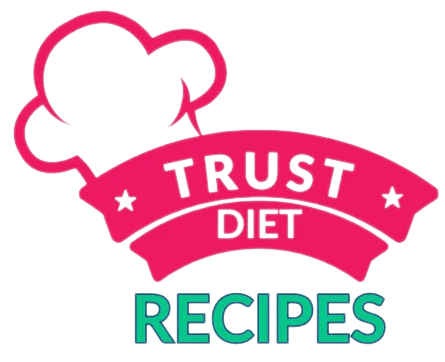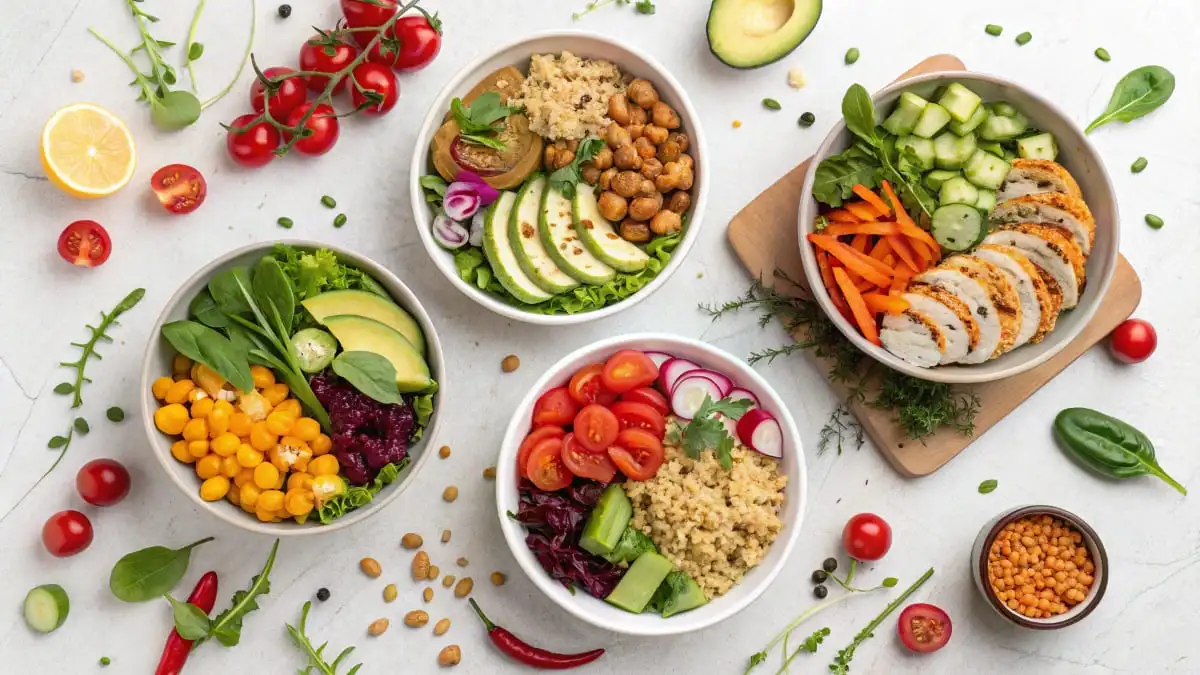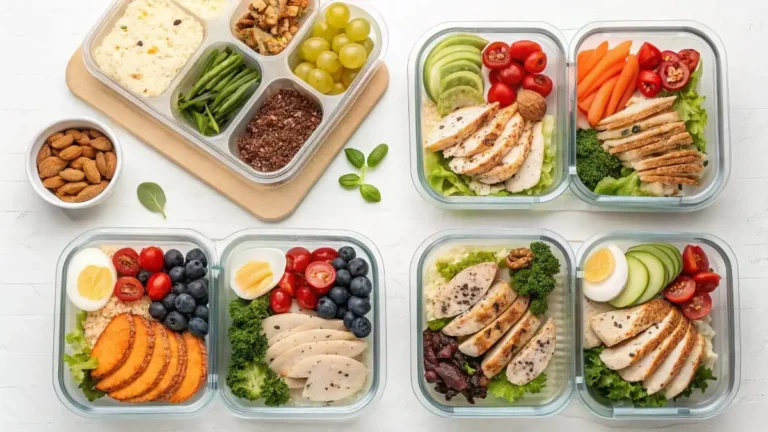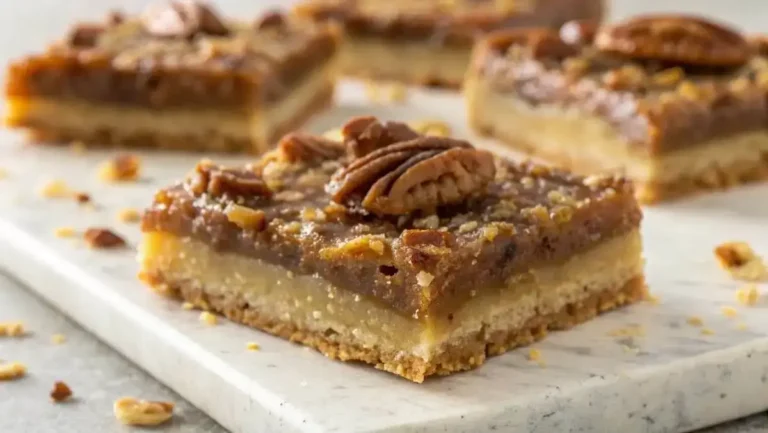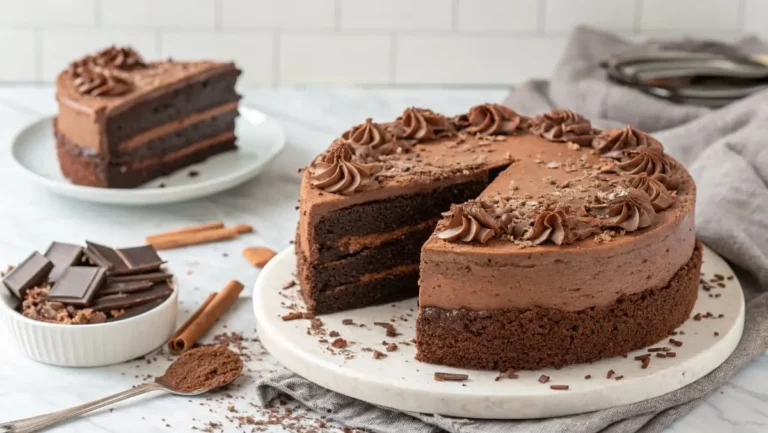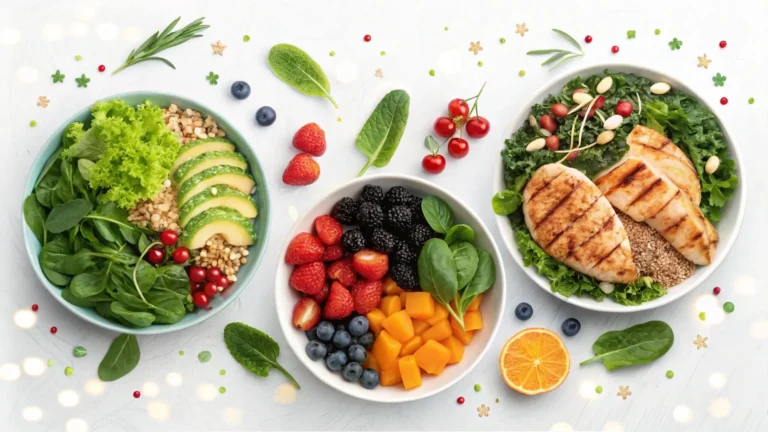How to Make A Gluten Free Meal Plan For The Week?
Eating Well Gluten Free: Easier Than You Think with a Meal Plan
Going gluten-free? Don’t let the idea of restrictions and complicated recipes scare you! Many people initially think a gluten-free diet is a big challenge. You might even believe that developing a gluten free meal plan means sacrificing flavor and spending all your time in the kitchen. But guess what? The right gluten free meal plan is actually your secret weapon! Eating well gluten-free, with a good plan in hand, can be much easier, more enjoyable, and less time-consuming than you might expect.
More and more people are exploring gluten-free diets, whether for health reasons like celiac disease or gluten sensitivity, or simply to feel better overall. While it’s true that you need to avoid gluten – a protein found in wheat, barley, and rye – it doesn’t mean your meals have to be boring or difficult to prepare.
The secret to stress-free and delicious gluten-free eating? Meal planning! Taking a little time to plan your meals for the week ahead can completely transform your gluten-free journey. It makes grocery shopping simpler, and cooking faster, and ensures you always have healthy and tasty gluten-free options readily available.
This article is your friendly guide to creating your very own gluten free meal plan for the week. We’ll break it down into easy-to-follow steps, share delicious recipe ideas, and give you all the tips you need to make gluten-free meal planning a success. Get ready to discover how simple and satisfying gluten-free eating can be!
Table of Contents
Understanding Gluten and Why Go Gluten Free
What Exactly is Gluten?
Before we dive into meal planning, let’s quickly understand what gluten actually is. Gluten is a family of proteins naturally found in certain grains, most commonly wheat, but also barley and rye. Think of gluten as the “glue” that holds these grains together and gives bread its chewy texture.
You’ll find gluten in many everyday foods, including:
- Breads: Wheat bread, white bread, sourdough, rye bread, and many more.
- Pasta: Traditional pasta made from wheat semolina.
- Cereals: Many breakfast cereals, especially those not specifically labeled gluten-free.
- Baked Goods: Cakes, cookies, pastries, muffins, crackers – often made with wheat flour.
- Sauces and Gravies: Sometimes thickened with wheat flour.
- Processed Foods: Gluten can sneak into unexpected places as a binding agent or stabilizer.
It’s important to be aware of these common sources of gluten when you’re planning a gluten-free diet.
Reasons for Choosing a Gluten Free Diet
People choose to go gluten-free for various reasons, most commonly for health concerns:
- Celiac Disease: This is a serious autoimmune disorder where gluten triggers an immune response in the small intestine. Over time, this reaction damages the lining of the small intestine, preventing the absorption of nutrients. For people with celiac disease, strictly avoiding gluten is essential for their health and well-being. Even small amounts of gluten can cause significant symptoms and long-term damage.
- Non-Celiac Gluten Sensitivity (NCGS): Also known as gluten intolerance, NCGS is a condition where individuals experience symptoms similar to celiac disease after eating gluten, but without the same intestinal damage. Symptoms can include bloating, abdominal pain, fatigue, headaches, and brain fog. While not as severe as celiac disease, NCGS can significantly impact quality of life, and a gluten-free diet can provide relief.
- Other Potential Benefits: Even for those without celiac disease or gluten sensitivity, some people find they feel better overall on a gluten free diet. They may experience improved digestion, increased energy levels, reduced bloating, or clearer skin. While more research is needed in this area, some individuals report feeling healthier and more energetic when they eliminate gluten from their diet.
Want to learn more about the potential benefits of a gluten free diet, even if you don’t have celiac disease? Learn more about the potential benefits of a gluten free diet in this informative discussion on Quora.
The Amazing Benefits of Gluten Free Meal Planning
Healthier Eating, Simplified:
Going gluten-free doesn’t automatically mean eating healthier. Many processed gluten-free products can be high in sugar, unhealthy fats, and low in nutrients. However, gluten free meal planning helps you focus on naturally gluten-free whole foods, leading to a truly healthier diet.
When you plan your gluten free meals, you’re more likely to:
- Choose Whole, Unprocessed Foods: You’ll naturally gravitate towards fruits, vegetables, lean proteins, and gluten free grains like quinoa and rice, which are packed with vitamins, minerals, and fiber.
- Limit Processed Gluten Free Foods: Planning helps you reduce reliance on pre-packaged gluten-free breads, snacks, and desserts, which can sometimes be less nutritious.
- Increase Nutrient Intake: By focusing on whole foods, you ensure you’re getting a wide range of essential nutrients that support overall health and well-being.
Save Precious Time During the Week:
Life is busy, and figuring out what to eat every day, especially when you’re on a gluten-free diet, can be time-consuming and stressful. Gluten-free meal planning is your time-saving superhero!
- Efficient Grocery Shopping: With a meal plan, you create a targeted grocery list. No more wandering through the aisles wondering what to buy. You know exactly what you need, making shopping trips faster and more efficient.
- Faster Weeknight Meals: Knowing what you’re cooking each night eliminates the “what’s for dinner?” panic. You can prep ingredients in advance, and cooking becomes quicker and less stressful.
- Less Decision Fatigue: Making daily meal decisions can be mentally draining. Meal planning removes this daily decision-making burden, freeing up your mental energy for other things.
Reduce Food Waste and Save Money:
Gluten-free products can sometimes be more expensive than their gluten-containing counterparts. Meal planning can help you save money and reduce food waste on a gluten free diet.
- Avoid Impulse Buys: A meal plan helps you buy only the groceries you need for the week, reducing impulse purchases of unnecessary or expensive gluten-free items you might not use.
- Minimize Food Spoilage: Planning meals ensure you use up your groceries before they spoil. You’re less likely to have forgotten vegetables wilting in the crisper drawer when you have a clear plan for using them.
- Eat Out Less: Having pre-planned, delicious gluten-free meals at home reduces the temptation to eat out, which can be significantly more expensive, especially when seeking gluten-free options.
Stick to Your Gluten Free Goals with Ease:
Staying consistent with a gluten-free diet, especially when you’re new to it, can be challenging. Meal planning provides the structure and support you need to succeed.
- Reduces Temptation: When you have a plan and pre-prepared meals, you’re less likely to be tempted by convenient but gluten-containing foods when hunger strikes.
- Provides Structure and Routine: Meal planning creates a routine around your gluten-free eating, making it easier to stick to the diet long-term.
- Boosts Confidence: Successfully following a gluten-free meal plan boosts your confidence and empowers you to manage your diet effectively.
To make your gluten free meal prep even more efficient, consider using meal prep containers. Maximize your meal prep efficiency with the right containers and discover how they can help you store and organize your delicious gluten-free meals throughout the week.
Your Step-by-Step Guide to Creating a Gluten Free Meal Plan
Ready to create your gluten-free meal plan? Here’s a simple step-by-step guide to get you started:
Step 1: Assess Your Needs and Preferences
Before you start planning, take a moment to think about your individual needs and preferences:
- Dietary Needs and Goals: Are you following a gluten-free diet for celiac disease, gluten sensitivity, or another reason? Do you have any other dietary restrictions or preferences (e.g., dairy-free, vegetarian, low-carb)? Are you aiming for weight loss, weight maintenance, or muscle gain? Understanding your specific needs will help you tailor your meal plan.
- Favorite Gluten-Free Foods and Cuisines: What gluten-free foods do you already enjoy? What types of cuisines do you love (e.g., Italian, Mexican, Asian)? Incorporate foods you like into your plan to make it enjoyable and sustainable.
- Meals and Snacks per Day: Think about your daily routine. How many meals do you typically eat? Do you need to plan for breakfast, lunch, dinner, and snacks? Plan for what fits your lifestyle and hunger patterns.
Step 2: Choose Delicious Gluten Free Recipes
Now for the fun part – choosing recipes!
- Start with Familiar Favorites: Begin by identifying recipes you already make and enjoy that are naturally gluten-free or easily adaptable to be gluten-free. Think about simple dishes like grilled chicken and vegetables, rice bowls, or egg dishes.
- Explore Gluten-Free Recipe Resources: The internet is a treasure trove of gluten-free recipes! Explore websites, blogs, and cookbooks dedicated to gluten-free cooking. Look for recipes that use naturally gluten-free ingredients and are easy to prepare. Find a wealth of delicious and easy gluten-free recipes here on our website to inspire your meal plan!
- Focus on Naturally Gluten-Free Ingredients: Build your meals around naturally gluten-free staples like:
- Grains: Quinoa, rice (brown, white, wild), oats (certified gluten-free), corn, millet, sorghum.
- Vegetables: All vegetables are naturally gluten-free! Load up on colorful options.
- Fruits: All fruits are naturally gluten-free!
- Proteins: Lean meats, poultry, fish, eggs, beans, lentils, tofu, nuts, and seeds.
- Dairy (if tolerated): Milk, yogurt, cheese (check labels for additives).
- Healthy Fats: Avocado, olive oil, coconut oil, nuts, seeds.
Step 3: Build Your Weekly Meal Plan (Example Included)
Create a simple template for your weekly meal plan. A table format works well:
Gluten Free Weekly Meal Plan Table
| Day | Breakfast | Lunch | Dinner | Snacks |
| Monday | Gluten-Free Oatmeal with Berries | Quinoa Salad with Roasted Vegetables | Baked Chicken with Sweet Potato & Broccoli | Apple slices with almond butter |
| Tuesday | Gluten-Free Frittata Muffins | Leftover Baked Chicken & Veggies | Gluten-Free Lentil Soup | Handful of almonds, Gluten-free yogurt |
| Wednesday | Gluten-Free Yogurt with Fruit & Nuts | Gluten-Free Chicken Salad Lettuce Wraps | Baked Salmon with Roasted Asparagus & Lemon | Carrot sticks with hummus |
| Thursday | Gluten-Free Oatmeal with Banana | Quinoa Salad with Chickpeas & Avocado | Leftover Baked Salmon & Asparagus | Hard-boiled egg, Orange |
| Friday | Gluten-Free Breakfast Frittata | Leftover Quinoa & Chickpea Salad | Homemade Gluten-Free Pizza (using GF crust) | Berries, Gluten-free crackers & cheese |
| Saturday | Scrambled Eggs with Vegetables | Salad with Grilled Chicken | Gluten-free pasta with Marinara & Veggies | Popcorn (air-popped), Fruit salad |
| Sunday | Gluten-Free Pancakes with Syrup | Leftover Gluten-Free Pasta | Roast Beef with Roasted Root Vegetables | Celery sticks with peanut butter |
- Fill in the Meal Slots: Start filling in your meal plan template with the recipes you’ve chosen. Aim for variety throughout the week, but don’t be afraid to repeat meals or components to simplify cooking.
- Balance Variety and Repetition: Include a mix of different proteins, vegetables, and gluten-free grains. However, repeating breakfast and lunch options throughout the week can save time and effort.
- Plan for Leftovers: Intentionally plan to make larger portions of dinner so you have leftovers for lunch the next day. This is a huge time-saver!
Step 4: Create a Smart Gluten Free Grocery List
Once your meal plan is set, creating a grocery list is straightforward:
- List All Ingredients: Go through your meal plan and write down every ingredient you’ll need for each recipe.
- Organize by Grocery Store Sections: Group your list by grocery store sections (produce, protein, pantry, dairy, etc.). This makes shopping much faster and more organized.
- Check Your Pantry: Before heading to the store, check your pantry and refrigerator for items you already have to avoid buying duplicates.
For more tips on efficient grocery shopping, check out this guide for efficient gluten-free grocery shopping to make your shopping trips a breeze.
Step 5: Prep Ingredients and Get Cooking!
Now it’s time to put your plan into action!
- Dedicate Prep Time: Set aside some time each week (e.g., Sunday afternoon or evening) for meal prep. Even an hour or two of prep can make a huge difference during the week.
- Batch Cook Key Components: Focus on batch cooking components that can be used in multiple meals. For example:
- Cook a large batch of quinoa or rice.
- Roast a tray of mixed vegetables.
- Grill or bake chicken breasts or salmon fillets.
- Prepare a large pot of gluten-free soup or stew.
- Chop Veggies and Prep Ingredients: Wash and chop vegetables, measure out spices, and prepare any sauces or dressings in advance. Having ingredients prepped makes weeknight cooking much quicker.
Kitchen Tip: Cook extra portions of grains like quinoa or rice to use in different meals throughout the week. Roasted vegetables are also versatile for salads, bowls, and sides.
Step 6: Store Your Gluten-Free Meals Properly
Proper storage is crucial for keeping your gluten-free meals fresh and safe to eat throughout the week.
- Use Airtight Meal Prep Containers: Store your cooked meals in airtight meal prep containers to maintain freshness and prevent leaks.
- Refrigerate Promptly: Refrigerate cooked meals within 1-2 hours of cooking to prevent bacterial growth.
- Follow Food Safety Guidelines: Generally, cooked meals stored in meal prep containers will last for 3-4 days in the refrigerator. Always follow food safety guidelines and use your best judgment.
- Label Containers: Label each container with the contents and the date of preparation for easy identification and to track freshness.
Choose the right meal prep containers to keep your gluten-free meals fresh and ensure your planned gluten-free meals stay delicious all week long.
Delicious Gluten Free Recipe Ideas for Your Meal Plan
Here are some simple and delicious gluten-free recipe ideas to get you started with your meal plan. Measurements are provided in weights for accuracy.
Gluten-Free Breakfast Ideas:
Gluten-free oatmeal with Berries and Nuts
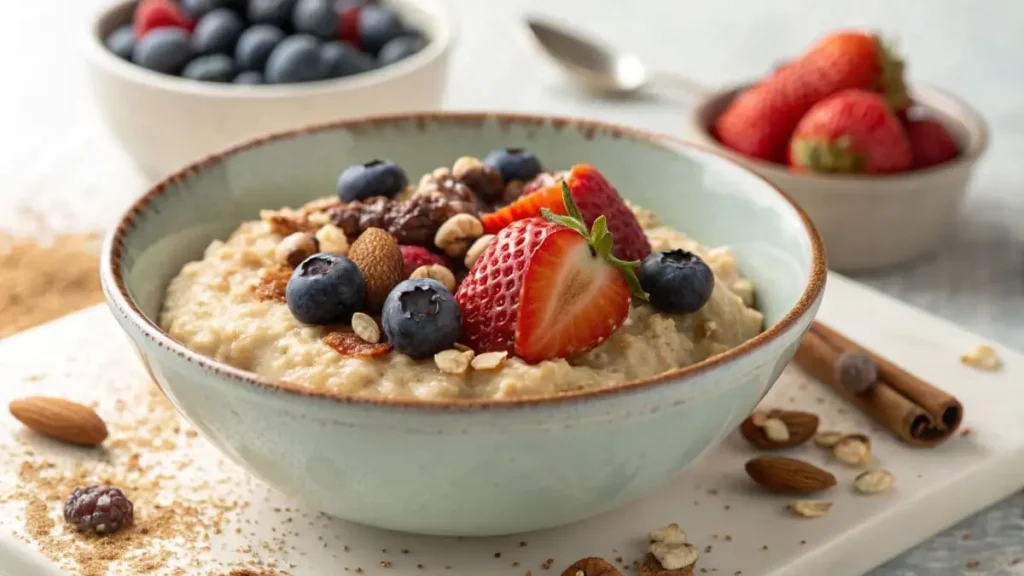
Ingredients (per serving):
- Certified Gluten-Free Rolled Oats: 50g (about ½ cup)
- Milk (dairy or non-dairy): 150ml (about ¾ cup)
- Water: 50ml (about ¼ cup)
- Berries (fresh or frozen): 75g (about ½ cup)
- Nuts (chopped): 20g (about 2 tablespoons)
- Optional Sweetener (maple syrup, honey, etc.): to taste
Instructions:
- Combine gluten-free oats, milk, and water in a saucepan.
- Bring to a boil, then reduce heat and simmer for 5-7 minutes, or until oats are cooked to your desired consistency.
- Pour oatmeal into a bowl or meal prep container.
- Top with berries and nuts. Add sweetener if desired.
Recipe Idea: Gluten Free Breakfast Frittata Muffins
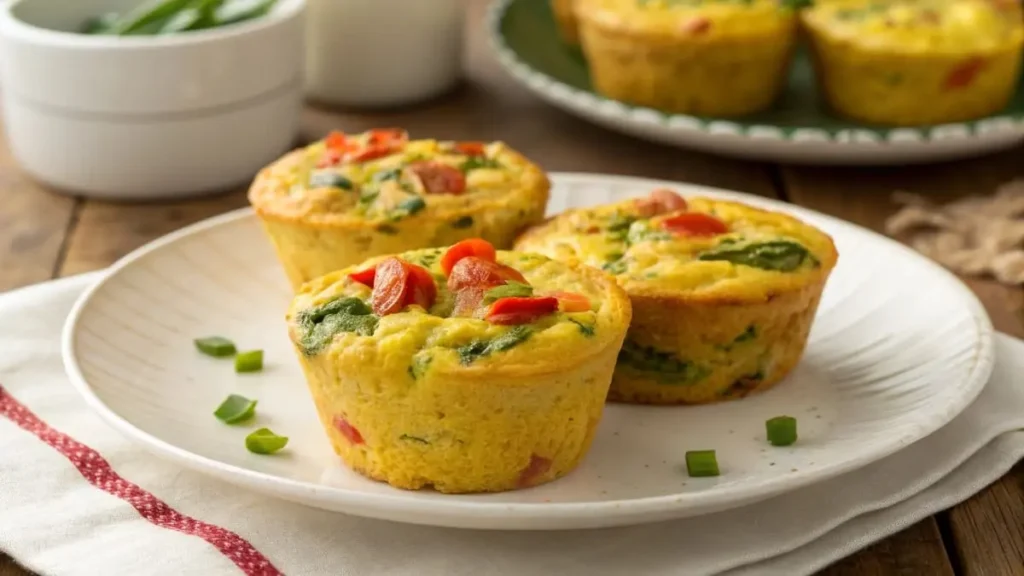
Ingredients (for 6 muffins):
- Eggs: 300g (about 6 large)
- Vegetables (diced, e.g., bell peppers, spinach, onions): 150g (about 1 ½ cups)
- Cheese (shredded, gluten-free): 50g (about ½ cup)
- Milk (dairy or non-dairy): 30ml (about 2 tablespoons)
- Salt: 2g (about ½ teaspoon)
- Black Pepper: 1g (about ¼ teaspoon)
- Optional Gluten-Free Add-ins (cooked ham, gluten-free sausage crumbles): 50g (about ½ cup)
Instructions:
- Preheat oven to 175°C (350°F). Grease a 6-cup muffin tin.
- In a bowl, whisk together eggs, milk, salt, and pepper.
- Stir in vegetables, cheese, and any optional add-ins.
- Pour egg mixture evenly into muffin cups.
- Bake for 20-25 minutes, or until muffins are set and lightly golden.
- Let cool slightly before serving or storing in meal prep containers.
Gluten-Free Lunch Ideas:
Quinoa Salad with Chickpeas and Avocado
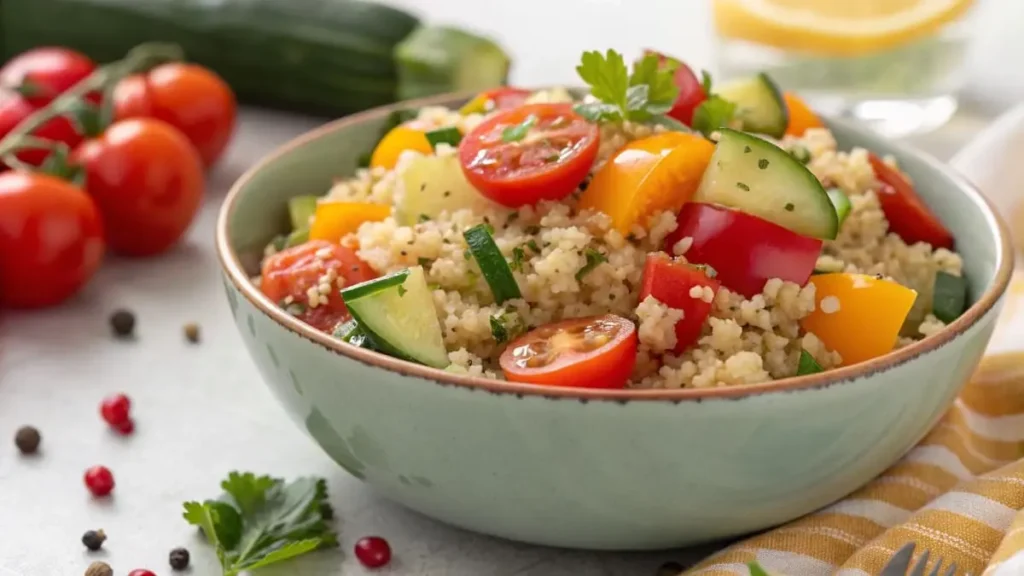
Ingredients (per serving):
- Cooked Quinoa: 150g (about ¾ cup)
- Chickpeas (canned, rinsed, and drained): 100g (about ½ cup)
- Avocado (diced): 75g (about ½ medium)
- Cucumber (diced): 50g (about ½ cup)
- Red Bell Pepper (diced): 50g (about ½ cup)
- Red Onion (finely diced): 20g (about ¼ small)
- Lemon Juice: 15ml (about 1 tablespoon)
- Olive Oil: 15ml (about 1 tablespoon)
- Salt: 1g (about ¼ teaspoon)
- Black Pepper: 0.5g (pinch)
Instructions:
- In a bowl, combine cooked quinoa, chickpeas, avocado, cucumber, red bell pepper, and red onion.
- In a small bowl, whisk together lemon juice, olive oil, salt, and pepper.
- Pour dressing over quinoa mixture and toss to combine.
- Serve immediately or store in meal prep containers.
Gluten-Free Chicken Salad Lettuce Wraps
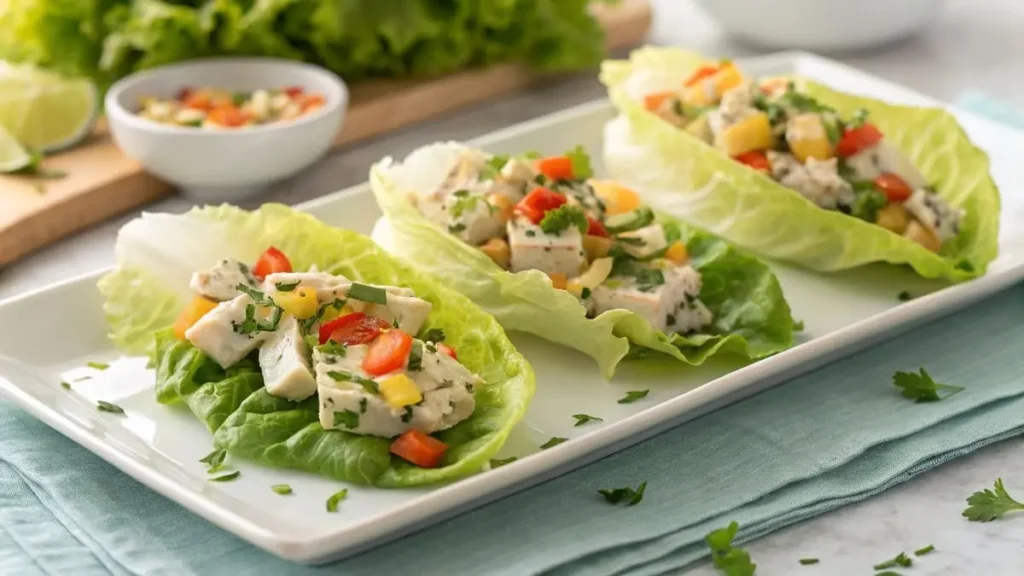
Ingredients (per serving):
- Cooked Chicken Breast (shredded or diced): 120g (about ½ cup)
- Celery (diced): 30g (about ¼ cup)
- Red Grapes (halved): 30g (about ¼ cup)
- Mayonnaise (gluten-free): 30g (about 2 tablespoons)
- Lemon Juice: 5ml (about 1 teaspoon)
- Salt: pinch
- Black Pepper: pinch
- Lettuce Leaves (e.g., romaine, butter lettuce): for wrapping
Instructions:
- In a bowl, combine shredded chicken, celery, and grapes.
- In a small bowl, whisk together mayonnaise, lemon juice, salt, and pepper.
- Pour dressing over chicken mixture and stir to combine.
- Serve chicken salad in lettuce wraps. Store chicken salad separately in meal prep containers and lettuce leaves separately to prevent wilting.
Gluten-Free Dinner Ideas:
Baked Salmon with Roasted Asparagus and Lemon
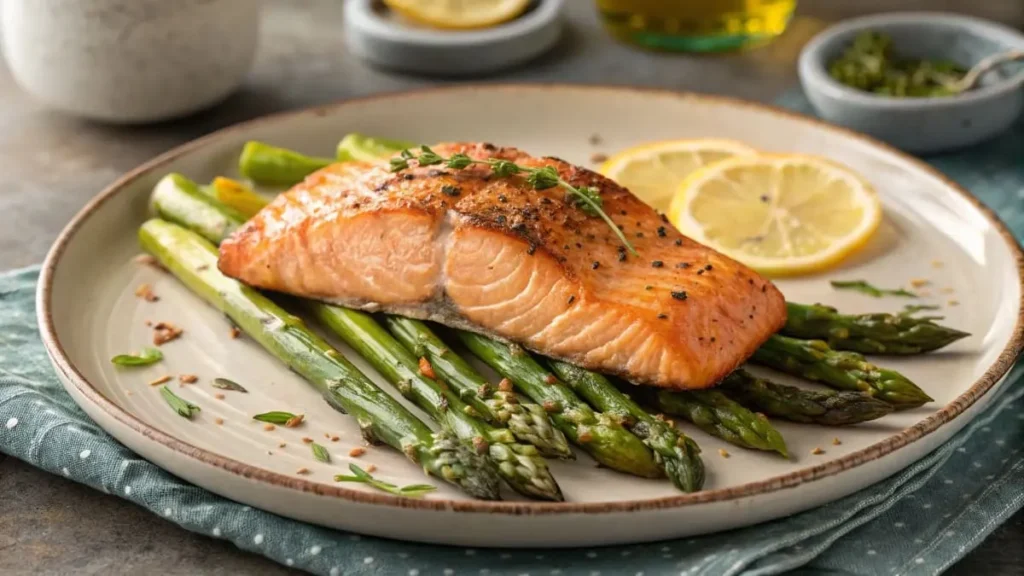
Ingredients (per serving):
- Salmon Fillet: 150g (about 5 oz)
- Asparagus (trimmed): 150g (about 1 bunch)
- Lemon (sliced): ½ lemon
- Olive Oil: 15ml (about 1 tablespoon)
- Salt: 1g (about ¼ teaspoon)
- Black Pepper: 0.5g (pinch)
- Optional Herbs (dill, parsley): to taste
Instructions:
- Preheat oven to 200°C (400°F).
- Toss asparagus with olive oil, salt, and pepper. Spread on a baking sheet.
- Place the salmon fillet on the same baking sheet. Top with lemon slices and optional herbs.
- Bake for 12-15 minutes, or until salmon is cooked through and asparagus is tender-crisp.
- Serve immediately or store salmon and asparagus separately in meal prep container.
Gluten-Free Lentil Soup
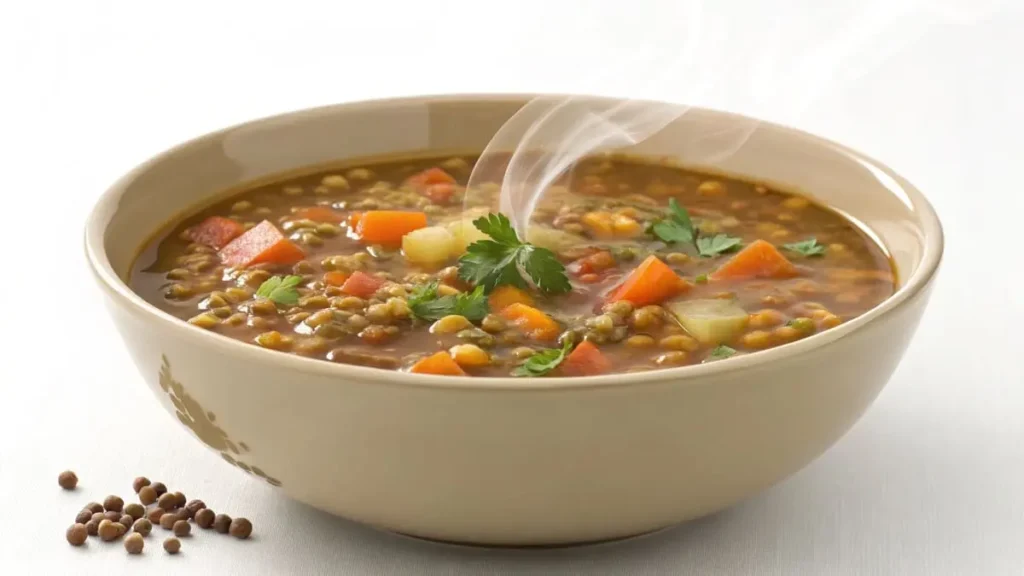
Ingredients (per serving):
- Lentils (brown or green), rinsed: 75g (about ⅓ cup)
- Vegetable Broth: 300ml (about 1 ½ cups)
- Carrots (diced): 50g (about ½ medium)
- Celery (diced): 50g (about 1 stalk)
- Onion (diced): 50g (about ½ small)
- Garlic (minced): 5g (about 1 clove)
- Olive Oil: 10ml (about 2 teaspoons)
- Dried Thyme: 1g (about ¼ teaspoon)
- Bay Leaf: 1
- Salt: 1g (about ¼ teaspoon)
- Black Pepper: 0.5g (pinch)
Instructions:
- Heat olive oil in a pot. Add onion, carrots, and celery and cook until softened, about 5 minutes. Add garlic and cook for 1 minute more.
- Add lentils, vegetable broth, thyme, bay leaf, salt, and pepper.
- Bring to a boil, then reduce heat and simmer for 20-25 minutes, or until lentils are tender.
- Remove bay leaf. Serve hot or let cool and store in meal prep containers.
Gluten-Free Snack Ideas:
- Hard-boiled eggs
- Fruits (apples, bananas, berries, oranges, grapes)
- Vegetable sticks (carrot sticks, celery sticks, cucumber slices) with gluten-free hummus
- Nuts and seeds (portion-controlled – almonds, walnuts, sunflower seeds, pumpkin seeds)
- Gluten-free yogurt (plain or flavored, check labels) with berries or a sprinkle of gluten-free granola
Essential Tips for Successful Gluten Free Meal Planning
Become a Label Reading Expert:
Living gluten-free requires becoming a diligent label reader. Gluten can hide in unexpected places!
- Read Every Label, Every Time: Ingredients can change, so always check labels, even on products you’ve bought before.
- Look for “Gluten-Free” Certification: Certified gluten-free products have been tested and meet strict standards for gluten content, offering more assurance.
- Be Aware of Hidden Gluten: Watch out for ingredients like “modified food starch,” “malt flavoring,” “soy sauce,” and “natural flavoring,” which can sometimes contain gluten. When in doubt, contact the manufacturer or choose certified gluten-free alternatives.
Prevent Cross-Contamination in Your Kitchen:
If you share a kitchen with others who eat gluten, preventing cross-contamination is crucial, especially for those with celiac disease.
- Separate Cutting Boards and Utensils: Use separate cutting boards, knives, toasters, and colanders specifically for gluten-free food preparation. Color coding can be helpful.
- Clean Surfaces Thoroughly: Clean countertops, cutting boards, and utensils thoroughly with soap and water after preparing gluten-containing foods.
- Store Gluten-Free Foods Separately: Store gluten-free foods in designated areas in your pantry and refrigerator, away from gluten-containing items, to prevent accidental contamination.
Eating Out Gluten-Free with Confidence:
Eating out gluten-free is possible, but it requires some planning and communication.
- Research Restaurants in Advance: Before you go out, check restaurant menus online for gluten-free options. Many restaurants now offer gluten-free menus or clearly mark gluten-free dishes.
- Communicate Clearly with Restaurant Staff: When ordering, clearly inform your server about your gluten-free needs and any allergies.
- Ask Questions: Don’t hesitate to ask questions about ingredients and preparation methods. Inquire about cross-contamination risks, especially if you have celiac disease.
For even more dietary guidance and meal plan inspiration, including potentially more specialized gluten-free options, Explore more special diet meal plans for various dietary needs on our website.
Stay Motivated and Consistent:
Meal planning and gluten-free eating are journeys, not destinations.
- Start Small and Be Patient: Begin with planning just a few meals per week and gradually increase as you get comfortable. Be patient with yourself as you learn and adjust to gluten-free eating.
- Don’t Get Discouraged by Slip-Ups: Everyone makes mistakes. If you accidentally eat gluten, don’t get discouraged. Just learn from it and get back on track with your plan.
- Celebrate Your Successes: Acknowledge and celebrate your progress and the positive changes you experience from gluten-free meal planning. Focus on how good you feel and the benefits you’re gaining.
FAQ: Your Questions About Gluten-Free Meal Plans Answered
Q: What is a gluten-free meal plan, and who is it for?
- A: A gluten-free meal plan is a pre-planned schedule of meals and snacks that specifically excludes gluten-containing ingredients. It’s for anyone who needs or chooses to avoid gluten, including individuals with celiac disease, non-celiac gluten sensitivity, or those simply wanting to explore gluten-free eating for potential health benefits.
Q: How do I start creating my first gluten-free meal plan for the week?
- A: Start by assessing your dietary needs and preferences, then choose a few simple gluten-free recipes you enjoy. Use a weekly template to fill in your meals, create a grocery list, and dedicate time to prep and cook. Begin small and gradually build your routine.
Q: Are gluten-free meal plans expensive?
- A: Not necessarily. By focusing on whole, naturally gluten-free foods and reducing reliance on expensive processed gluten-free products, a gluten-free meal plan can be budget-friendly. Planning also helps reduce food waste and eating-out expenses, potentially saving you money overall.
Q: Can a gluten-free meal plan help with weight loss?
- A: Yes, a well-structured gluten-free meal plan can support weight loss. By focusing on whole, unprocessed gluten-free foods, you naturally reduce the intake of processed foods, unhealthy fats, and added sugars often found in gluten-containing diets. Meal planning also promotes portion control and mindful eating, which are helpful for weight management.
Q: Where can I find more gluten-free meal plan recipe ideas?
- A: You can find tons of gluten-free recipe ideas online on websites and blogs dedicated to gluten-free cooking. Explore cookbooks, social media, and recipe apps. Also, don’t forget to check out our Gluten-Free Recipes section for delicious inspiration!
Conclusion: Embrace Gluten-Free Meal Planning for a Delicious and Healthy Life

Creating a gluten-free meal plan might seem like an extra effort at first, but the rewards are well worth it. From simplifying your week and saving time to eating healthier and sticking to your gluten-free goals with ease, the benefits are undeniable.
Gluten-free eating doesn’t have to be restrictive or complicated. With a little planning and the right recipes, it can be a delicious, satisfying, and health-promoting way of life. Embrace gluten-free meal planning, take it one step at a time, and discover how enjoyable and empowering it can be to nourish your body with wholesome, gluten-free foods. Start planning your gluten-free week today and experience the positive changes for yourself!
